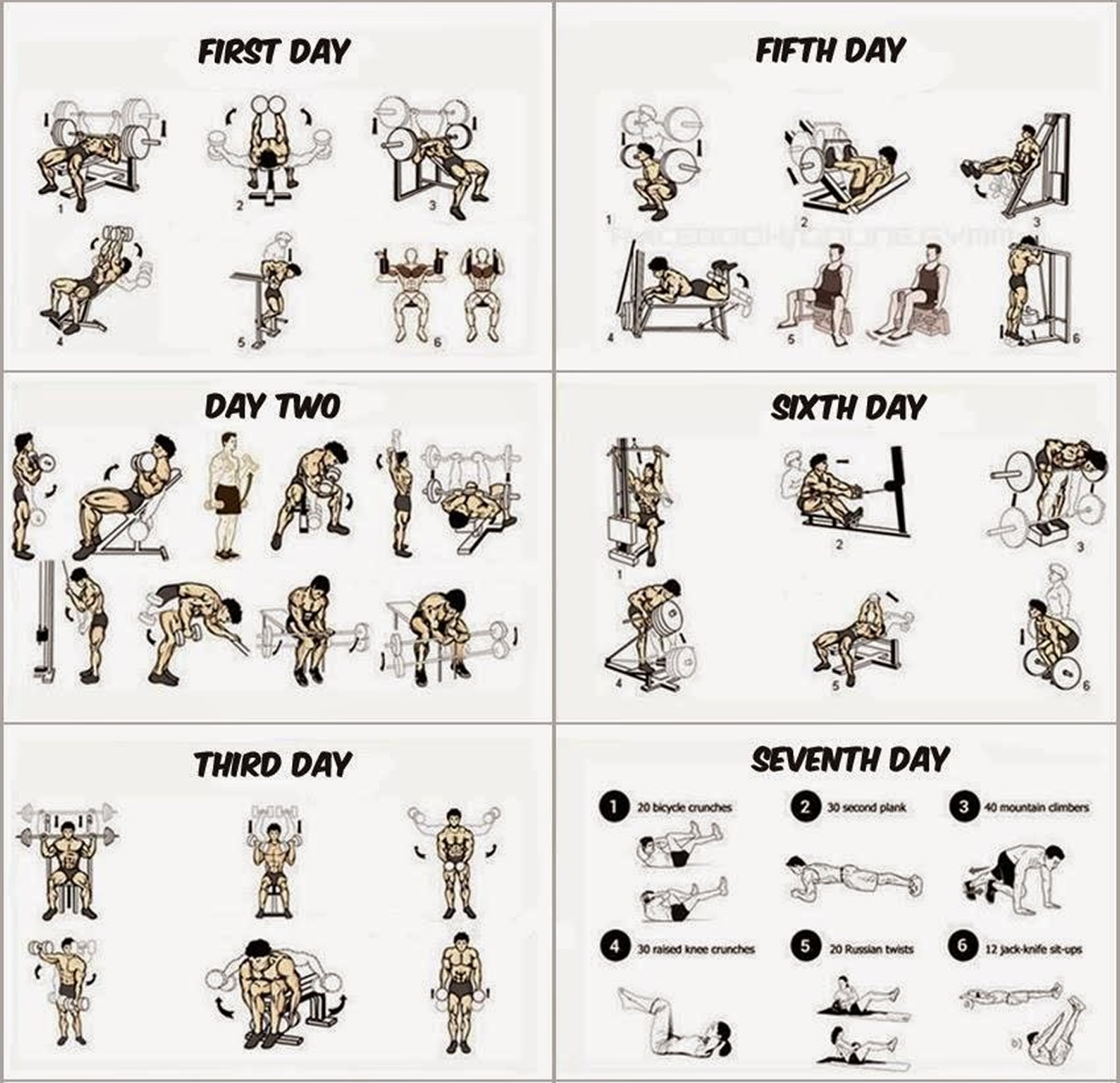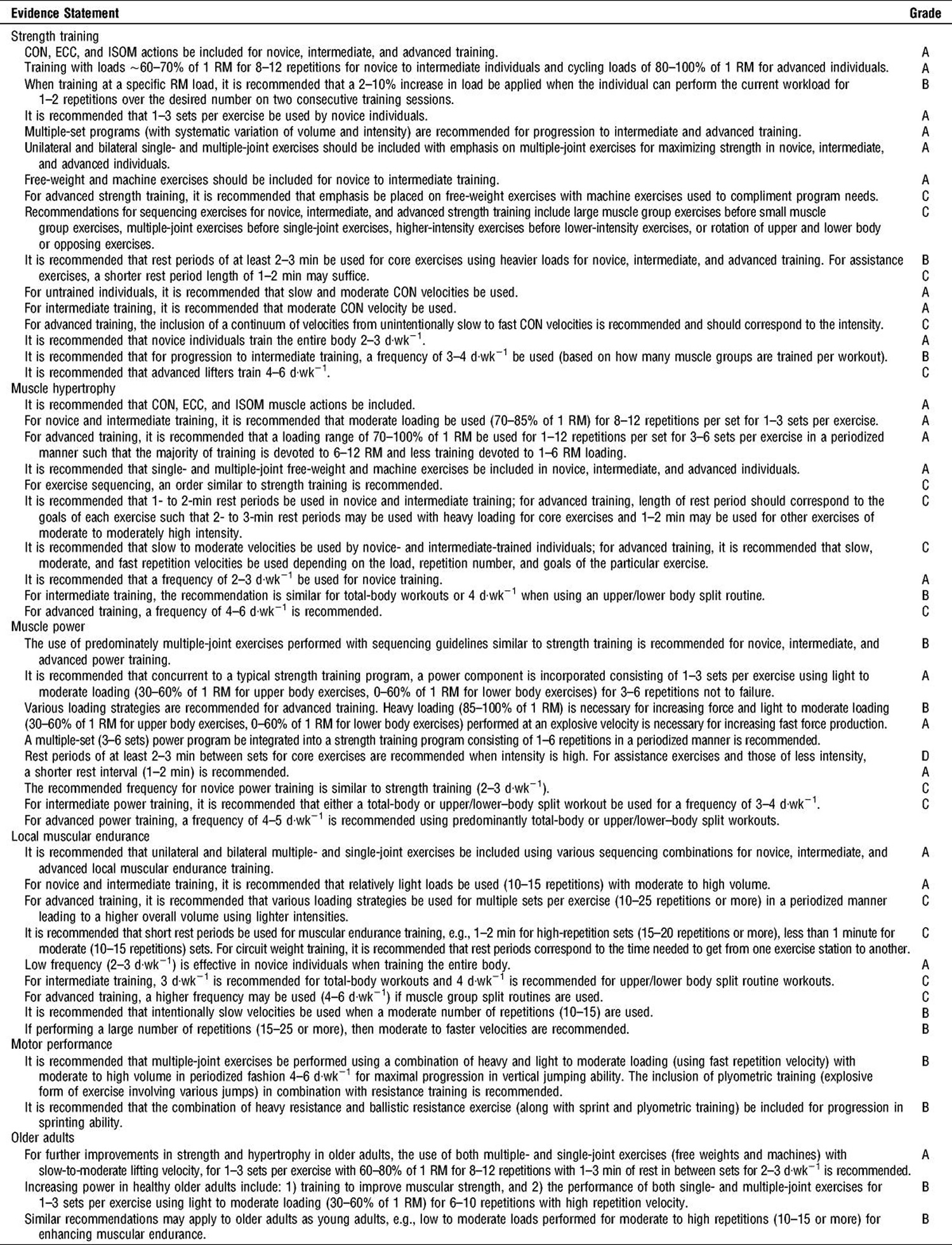Best workout routine for building muscle
The American College of Sports Medicine (ACSM) recommends that a strength training program should be performed a minimum of two non-consecutive days each week, with one set of 8 to 12 repetitions for healthy adults or 10 to 15 repetitions for older and frail individuals 1. Eight to 10 exercises should be performed that target the major muscle groups 1. Examples of typical resistance exercises that can be performed using free-weights, machines, or body weight for the major muscle groups are:
Table 1. RESISTANCE TRAINING GUIDELINES AND EXERCISES
Free-Weight | Machine-Based | Body Weight | |
| Chest | Supine Bench Press | Seated Chest Press | Push-ups |
| Back | Bent-over Barbell Rows | Lat Pulldown | Pull-ups |
| Shoulders | Dumbell Lateral Raise | Shoulder Press | Arm Circles |
| Biceps | Barbell/Dumbell Curls | Cable Curls | Reverse Grip Pull-ups |
| Triceps | Dumbell Kickbacks | Pressdowns | Dips |
| Abdomen | Weighted Crunches | Seated “Abs” Machine | Crunches, Prone Planks |
| Quadriceps | Back Squats | Leg Extenstion | Body weight lunges |
| Hamstrings | Stiff-leg Deadlifts | Leg Curls | Hip-ups |
The American College of Sports Medicine (ACSM) stresses the importance of progressing resistance training programs to meet specific resistance training goals. Progression in resistance training may be defined as “the act of moving forward or advancing toward a specific goal over time until the target goal has been achieved,” whereas maintenance resistance training refers to programs designed to maintain the current level of muscular fitness 1. This can occur with specific trainable characteristics of muscular fitness, such as strength, power, muscle hypertrophy and local muscular endurance. These four factors will improve with almost any properly designed resistance training program, but will be fully enhanced by properly modifying the load, volume, rest period between sets, and the frequency of each workout.
Countless resistance training models can be effective if these principles are incorporated and manipulated into the design. The magnitude of improvement depends upon the individual’s training status and genetic predisposition 2. Progressive overload is the gradual increase of stress placed upon the body during exercise training. Among untrained or novice populations, physiological adaptations to an resistance training program may occur in a short period. Systematically increasing the demands placed upon the body is necessary for further improvement and may be accomplished through altering one or more of the following variables:
- Exercise intensity (i.e., absolute or relative resistance/load for a given exercise/movement) may be increased;
- Total repetitions performed at the current intensity may be increased;
- Repetition speed/tempo with submaximal loads may be altered according to goals;
- Rest periods may be shortened for endurance improvements or lengthened for strength and power training; and
- Training volume (total work represented as the product of the total number of repetitions performed and the resistance) may be gradually increased (e.g., 2.5-5% 75) (Table 2).
Table 2. Muscle Building Workout Plan
[Source 3]Note: CON = the motion of an active muscle while it is shortening under load (contracting) ; ECC = the motion of an active muscle while it is lengthening under load; ISOM = static strength training, involve muscular actions in which the length of the muscle does not change and there is no visible movement at the joint (no movement).
Muscle Action
Most resistance training programs primarily include dynamic repetitions with both concentric (CON; muscle shortening) and eccentric (ECC; muscle lengthening) muscle actions, whereas isometric (ISOM; no net change in muscle length) actions play a secondary role (e.g., during nonagonist muscle stabilization, core strength, grip strength, pauses between eccentric (ECC) and concentric (CON) actions, or specific agonist ISOM exercises). Greater force per unit of muscle size is produced during eccentric (ECC) actions 4 than either CON or ISOM actions. Moreover, eccentric (ECC) actions require less motor unit activation per specific load 4, are less metabolically demanding 5, and are conducive to promoting hypertrophic adaptation 6 yet result in more pronounced delayed onset muscle soreness 7 as compared with concentric (CON) actions. Dynamic concentric (CON) muscular strength improvement is greatest when ECC actions are included with CON actions 8, and independently, ECC isokinetic training has been shown to produce greater muscle action-specific strength gains than CON training 9. The role of muscle action manipulation during resistance training is minimal with respect to overall progression because most programs include both CON and ECC actions in a given repetition. However, the inclusion of additional ISOM exercise may be beneficial. In some programs, the use of different forms of ISOM training, for example, functional ISOM 10 and supramaximal ECC actions (Keogh JWL, Wilson GJ, Weatherby RP. A cross-sectional comparison of different resistance training techniques in the bench press. J Strength Cond Res. 1999;13:247-58.)), has been reported to produce additional benefit. Specifically, certain ISOM actions have been recommended for promoting low back health and have been demonstrated effective for the selective recruitment of postural, spinal-stabilization musculature 11.
Repetition Speed
Less is known concerning the effect of repetition velocity on hypertrophy. In untrained individuals, fast (1:1) and moderate to slow (3:3) velocities of training produced similar changes in elbow flexor girth after 6 wk of training 12. However, 8 wk of fast (210°·s−1) ECC isokinetic training produced larger increases in Type II muscle fiber CSA than slow (20°/second) training 13, and 8 wk of fast ECC (180°·s−1) isokinetic training produced greater hypertrophy than slow ECC (30°/second), fast and slow CON training 9. For dynamic constant external resistance training, it has been suggested that higher velocities of movement pose less of a stimulus for hypertrophy than slow and moderate velocities. However, intentional slow velocities require significant reductions in loading and result in less of a blood lactate response and less metabolic response when total training time is equated 14. It does appear that the use of different velocities is warranted for long-term improvements in hypertrophy for advanced training.
It is recommended that slow to moderate velocities be used by novice- and intermediate-trained individuals. For advanced training, it is recommended that slow, moderate, and fast repetition velocities be used depending on the load, the repetition number, and the goals of the particular exercise 15, 16.
Exercise Selection
Both single- and multiple-joint exercises have been shown to be effective for increasing muscular strength in the targeted muscle groups using multiple modalities, for example, free weights, machines, cords, etc. 17, 18. Multiple-joint exercises, such as bench press and squat, require complex neural responses 19 and have generally been regarded more effective for increasing overall muscular strength because they enable a greater magnitude of weight to be lifted 20. Single-joint exercises, such as knee extensions and knee curls, have been used to target-specific muscle groups and pose a reduced level of skill and technical involvement. It is important to note that alterations in body posture, grip, and hand width/foot stance and position change muscle activation and alter the exercise. Thus, many variations or progressions of single- and multiple-joint exercises can be performed. Another way to vary exercise selection is to include unilateral as well as bilateral exercises. The level of muscle activation differs when an exercise is performed bilaterally versus unilaterally. Unilateral training may increase bilateral strength (in addition to unilateral strength), and bilateral training may increase unilateral strength 21. Unilateral training has been shown to improve some aspects of sports performance, such as single-leg jumping ability to a greater extent than bilateral training 21. Of interest has been the performance of single- and multiple-joint exercises in unstable environments, for example, with stability balls, wobble boards, and BOSU balls 22. These exercises have been shown to increase the activity of lower torso musculature and other stabilizer muscles (compared with stable environments); however, the magnitude of agonist force production is considerably lower resulting in lighter weights lifted 23. There are a multitude of exercises that can be performed in a variety of conditions that leaves many options for resistance training variation.
Free Weights and Machines
Weight machines have been regarded as safer to use, easy to learn, and allow performance of some exercises that may be difficult with free weights, for example, knee extension. Machines help stabilize the body and limit movement about specific joints involved in synergistic force production, and machine exercises have demonstrated less neural activation when matched for intensity for most comparisons to free-weight exercises 24. Unlike machines, free weights may result in a pattern of intra- and intermuscular coordination that mimics the movement requirements of a specific task. Both free weights and machines are effective for increasing strength. Research shows that free-weight training leads to greater improvements in free-weight tests and machine training results in greater performance on machine tests 25. When a neutral testing device is used, strength improvement from free weights and machines appears similar 26. The choice to incorporate free weights or machines should be based on level of training status and familiarity with specific exercise movements as well as the primary training objective.
Exercise Order
The sequencing of exercises significantly affects the acute expression of muscular strength 27. This also applies when exercises are sequenced based on agonist/antagonist muscle group relationships. Muscle force and power may be potentiated when opposing exercises (antagonist movements) are performed 28; however, force and power may be reduced if the exercises are performed consecutively 29. Studies show that multiple-joint exercise (bench press, squat, leg press, and shoulder press) performance declines significantly when these exercises are performed later (after several exercises stressing similar muscle groups) rather than early in a workout 30. Considering that these multiple-joint exercises have been shown to be effective for increasing strength, maximizing performance of these exercises by performing them early in a workout may be necessary for optimal strength gains 31.
Recommendations for sequencing exercises for novice, intermediate, and advanced strength training for total body (all muscle groups trained in the workout), upper/lower body split (upper-body musculature trained 1 d and lower-body musculature trained another day), and muscle group split (individual muscle groups trained during a workout) workouts include large muscle group exercises before small muscle group exercises, multiple-joint exercises before single-joint exercises, higher-intensity exercises before lower-intensity exercises, or rotation of upper and lower body or agonist-antagonist exercises, that is, exercise performed for a muscle group followed by an exercise for the opposing muscle group 32.
Adding High-Intensity Interval Training (HIIT) Workout To Your Weight Training Program
Traditionally, resistance training often is performed separately from aerobic training — typically on two or three nonconsecutive days each week. The American College of Sports Medicine recommends 8 to 12 repetitions of a resistance training exercise for each major muscle group at an intensity of 40% to 80% of a one-repetition max (1RM) depending on the training level of the participant. Two to three minutes of rest is recommended between exercise sets to allow for proper recovery. Two to four sets are recommended for each muscle group 1.
Standard guidelines for aerobic training recommend 150 minutes per week of moderate-intensity exercise (46% to 63% of maximal oxygen uptake, VO2max) for 30 to 60 minutes per session and/or 75 minutes per week of vigorous-intensity exercise (64% to 90% V˙O2max) for 20 to 60 minutes per session 1.
To address the limitations of traditional exercise protocols and provide an effective and efficient program for you, one of the exercise strategies to use is high intensity interval training (HIIT) using body weight as resistance. The approach combines aerobic and resistance training into a single exercise bout lasting approximately 7 minutes. Participants can repeat the 7-minute bout 2 to 3 times, depending on the amount of time you have. As body weight provides the only form of resistance, the program can be done anywhere.
High intensity interval training programs include short bursts of high-intensity activity performed at maximal effort (80-95 percent peak oxygen intake or VO2 max), separated by short periods of low-intensity work that allow partial recovery. The recovery periods may last equally as long as the work periods and are usually performed at 40% to 50% of a person’s estimated maximal heart rate. The workout continues with the alternating work and relief periods totaling 20 to 60 minutes. Two HIIT sessions a week is plenty, in addition to your other weight training workouts.
High-intensity interval training involves repeated short (<45 seconds) to long (2-4 minutes) bouts of rather high-intensity exercise interspersed with recovery periods. A typical high-intensity interval training session might include a three-minute warmup, four to six repetitions of a 30-second sprint followed by a 60-second active recovery, and a three-minute cool-down 33. High intensity interval training is not as complicated as you might think. Interval training is simply alternating bursts of intense activity with intervals of lighter activity. For instance, if your exercise is walking — if you’re in good shape, you might incorporate short bursts of jogging into your regular brisk walks. If you’re less fit, you might alternate leisurely walking with periods of faster walking. For example, if you’re walking outdoors, you could walk faster between certain mailboxes, trees or other landmarks.
High-Intensity Interval Resistance Training (HIRT) can be a fast and efficient way to lose excess body weight and body fat 34, 35, 36, 37. It has been proposed that short period resistance training could play a role in weight control by increasing resting energy expenditure but the effects of different kinds of resistance training has not been widely reported. The incorporated resistance training contributes significantly to the amount of fat burned during a workout 38. When resistance training exercises using multiple large muscles are used with very little rest between sets, they can elicit aerobic and metabolic benefits 39, 40, 35. Research has found that these metabolic benefits can be present for up to 72 hours after a high-intensity exercise bout has been completed 41.
There also may be a greater impact on subcutaneous fat loss with high-intensity intermittent circuit-style resistance training protocols than with traditional steady state sustained-effort aerobic work or traditional resistance training. This is thought to be from the increased level of catecholamines and growth hormone found in the blood both during and after high-intensity resistance training exercise with shortened rest periods (<30 seconds) 42, 35.
Shorter rest periods result in a shorter total exercise time. This is attractive to individuals who are trying to maximize the impact of an exercise program in minimal time.
In a small study involving 17 men doing resistance training, who were separated into doing the High-Intensity Interval Resistance Training (HIRT) consisting of: 6 repetitions, 20 seconds rest, 2/3 repetitions, 20 secs rest, 2/3 repetitions with 2 mins 30 seconds rest between sets, three exercises for a total of 7 sets. And the Traditional Resistance Training consisted of eight exercises of 4 sets of 8–12 repetitions with one/two minutes rest with a total amount of 32 sets. The researchers measured basal resting energy expenditure before the exercise and at 22 hours after the training session.
This data 43 suggest that shorter high-intensity interval resistance training sessions may increase resting energy expenditure at 22 hours after exercise to a greater extent than traditional resistance training and improving fat oxidation. The shorter exercise time commitment may help to reduce one major barrier to exercise.
Rest Periods
The amount of rest between sets and exercises significantly affects metabolic, hormonal and cardiovascular responses to an acute bout during resistance exercise as well as performance of subsequent sets and training adaptations. Acute resistance exercise performance may be compromised with one versus 3-min rest periods 44, and strength recovery may not be complete within 3 min 45. Several studies have shown that the number of repetitions performed may be compromised with short rest intervals, and 3- to 5-min rest intervals produce less performance decrements than 30 s to 2 min 46. In untrained individuals, circuit RT programs (using minimal rest in between exercises) have been shown to produce modest increases in strength 47. However, most longitudinal training studies have shown greater strength increases with long versus short rest periods (e.g., 2-5 min vs 30-40 s [3,213,230]), and one study has shown a lack of strength increase with 40-s rest periods 48. It is important to note that rest period length will vary based on the complexity of a given exercise (e.g., Olympic lifts and variations require longer rest periods) and the primary objective for incorporating the exercise into the training program (i.e., not every exercise will use the same rest interval).
For novice, intermediate, and advanced training, it is recommended that rest periods of at least 2-3 min be used for core exercises using heavier loads (those exercises included specifically to improve maximal strength such as the squat and bench press).
For assistance exercises (those exercises complimentary to core exercises), a shorter rest period length of 1-2 min may suffice 49.
Muscular Loading
The load is the amount of weight lifted in a given set, which is based on a percentage of the 1-repetition maximum (1RM). The volume is the total number of exercises, repetitions, and sets that are performed in a given exercise session. Rest period is the time period between each set and exercise. Frequency refers to the number of exercise sessions per week. How to manipulate each of these for the optimal enhancement of strength, power, hypertrophy, or muscular endurance is described below.
Altering the training load affects the acute metabolic, hormonal, neural, and cardiovascular responses to resistance exercise. Depending on an individual’s training experience and current level of fitness, proper loading during resistance training encompasses one or more of the following loading schemes:
- Increasing load based on a percentage of 1 RM,
- Increasing absolute load based on a targeted repetition number, or
- Increasing loading within a prescribed zone (e.g., 8-12 RM).
The load required to increase maximal strength in untrained individuals is fairly low. Loads of 45-50% of 1 RM (and less) have been shown to increase dynamic muscular strength in previously untrained individuals 50. Light loads that can be lifted a maximum of 15-25 repetitions have been shown to increase strength in moderately trained individuals 51. It appears greater loading is needed with progression. At least 80% of 1 RM is needed to produce further neural adaptations and strength during resistance training in experienced lifters 52. Several pioneering studies indicated that training with loads corresponding to 1-6 RM (mostly 5-6 RM) was most conducive to increasing maximal dynamic strength 53. Strength increases have been shown to be greater using heavy weights for 3-5 RM compared with 9-11 and 20-28 RM 54. Although significant strength increases have been reported using loads corresponding to 8-12 RM and lighter (33,149,250), this loading range may be inferior for maximizing strength in advanced lifters 52. Research examining periodized resistance training has demonstrated a need for variable-intensity loading schemes 55. Contrary to early suggestions of 6 RM loading, it appears that using a variety of training loads is most conducive to maximizing muscular strength 55. Meta-analytical data have shown that 60% of 1 RM produced the largest effect sizes for strength increases in novice individuals whereas 80% of 1 RM produced the largest effect sizes for strength increases in trained individuals 56 and 85% of 1 RM was most effective in athletes 57. For novice individuals, it has been suggested that moderate loading (50-60% of 1 RM or less) be used initially as learning proper form, and technique is paramount. These dose-response data refer to average training dosages, that is, mean loads used for all exercises. Further, using a variety of loads appears to be most effective for long-term progression in muscular strength 18. Recent studies have shown that self-selected resistance training intensities are lower than what is recommended, for example, 38-58% of 1 RM 58. Thus, intensity needs to be prescribed above one’s threshold (based on targeted repetition number) for progression in experienced populations.
Training Volume
Training volume is a summation of the total number of repetitions performed during a training session multiplied by the resistance used (kg) and is reflective of the duration of which muscles are being stressed 59. Training volume has been shown to affect neural, hypertrophic, metabolic and hormonal responses and subsequent adaptations to resistance training. Altering training volume can be accomplished by changing the number of exercises performed per session, the number of repetitions performed per set, or the number of sets per exercise. Low-volume programs, for example, high load, low repetitions, moderate to high number of sets, have been characteristic of resistance training. Studies using two 60, 61, three 44, 62, four to five 8, 63, and six or more 64, 65 sets per exercise have all produced significant increases in muscular strength in both trained and untrained individuals. In direct comparison, studies have reported similar strength increases in novice individuals between two and three sets 66 and two and four sets 67, whereas three sets have been reported superior to one and two 68. Although little is known concerning the optimal number of sets performed per muscle group per session, a meta-analysis of 37 studies has shown that approximately eight sets per muscle group produced the largest effect size in athletes 69, 70.
Another aspect that has received considerable attention is the comparison of single- and multiple-set programs. In many of these studies, one set per exercise performed for 8-12 repetitions at a relatively slow velocity has been compared with both periodized and nonperiodized multiple-set programs. A common criticism of these investigations is that the number of sets per exercise was not controlled from other variables such as intensity, frequency, and repetition velocity. Notwithstanding this concern, most research investigations comparing single- versus multiple-set training for muscular fitness have examined the effects of a standard single-set training program relative to that of any number of possible multiple-set programs of varying intensity. This design has made the process of identifying a clear-cut prescription recommendation very difficult because these studies have yielded conflicting results. Several studies have reported similar strength increases between single- and multiple-set programs 71, 72, whereas others reported multiple-set programs superior 73, 74 in previously untrained individuals. Since 2002, six studies have shown multiple-set superiority for 33-100% of the dynamic strength assessments used, whereas the remaining dynamic strength assessments showed similar increases. These data have prompted the notion that untrained individuals respond favorably to both single- and multiple-set programs and formed the basis for the popularity of single-set training among general fitness enthusiasts 75. In resistance-trained individuals, multiple-set programs have been shown to be superior for strength enhancement 76, 44, 77 in all but one study 78. Among resistance-trained postmenopausal women, multiple-set training led to 3.5-5.5% strength increases, whereas single-set training led to −1% to 2% strength reductions 76. No comparative study has shown single-set training superior to multiple-set training in trained or untrained individuals.
The results of meta-analytical studies have shown multiple-set resistance training superior to single sets for strength enhancement in untrained 79, 56 and trained populations 80 and superior for strength increases for programs lasting 17-40 wk 80. These studies have shown that performing three to four sets per exercise produced the most substantial effect sizes 79, 56. Thus, it appears that both program types are effective for increasing strength in untrained to moderately trained individuals during relatively short-term training periods. Long-term studies support the contention that a moderate increase in training volume is needed for further improvement. However, there is a point where further increase in volume may be counterproductive. In weightlifters, a moderate volume was shown to be more effective for increasing strength than low or high volumes of training with similar intensity 81. The key factor may be variation of training volume (and its interaction with intensity) rather than absolute number of sets.
Muscular Strength
The ability to generate force is necessary for all types of movement. Muscle fiber cross-sectional area (CSA) is positively related to maximal force production 82. The arrangement of fibers according to their angle of pennation, muscle length, joint angle, and contraction velocity can alter the expression of muscular strength 83. Force generation is further dependent upon motor unit activation, and motor units are recruited according to their recruitment threshold that typically involves the activation of the slower (lower force-producing) motor units before the faster (higher force-producing) units, that is, size principle 84. Adaptations to resistance training enable greater force generation through numerous neuromuscular mechanisms. Muscle strength may increase significantly within the first week of training 85, and long-term strength enhancement manifests itself through enhanced neural function (e.g., greater recruitment, rate of discharge), increased muscle fiber cross-sectional are, changes in muscle architecture and possible adaptations to increased metabolites, for example, H+, for increased strength. The magnitude of strength enhancement is dependent on the type of program used and the careful prescription of muscle actions, intensity, volume, exercise selection and order, rest periods between sets, and frequency.
Muscular strength is the ability of a muscle or muscle group to exert a maximal external force.
- Load: 60-70% 1RM for novice to intermediate; 80-100% for advanced
- Volume: 1-3 sets of 8-12 repetitions for novice to intermediate; 2-6 sets of 1-8 repetitions for advanced
- Rest period: 2-3 min for higher intense exercises that use heavier loads; 1-2 minutes between the lower intense exercises with light load.
Muscular Power
Power is defined as the optimal amount of work performed in a given time period. Muscular power is the highest power output attainable during a particular movement, and is required in activities of daily living, sport, and work. For optimal improvements in muscular power, a light load of 0 to 60% of 1RM should be used for 3-6 repetitions over one to three sets per exercise.
- Load: 30-60% 1RM for upper body exercises; 0-60% 1RM for lower body exercises
- Volume: 1-3 sets of 3-6 repetitions per exercise
- Rest period: 2-3 min for higher intense exercises that use heavier loads; 1-2 minutes between the lower intense exercises with light load.
Muscular Hypertrophy
Muscular hypertrophy is the enhancement of muscle size.
- Load: 70-85% 1RM for novice to intermediate; 70-100% for advanced
- Volume: 1-3 sets of 8-12 repetitions for novice to intermediate; 3-6 sets of 1-12 repetitions for advanced
- Rest period: 2-3 min for higher intense exercises that use heavier loads; 1-2 minutes between the lower intense exercises with light loads.
Muscular Endurance
Local muscular endurance is the ability of a muscle or a muscle group to repeatedly exert a submaximal resistance.
- Load: lower than 70% of 1RM
- Volume: 2-4 sets of 10-25 repetitions
- Rest period: 30 seconds to 1-minute between each set.
Frequency
For all the above, it is recommended that novice individuals train the entire body 2-3 days per week. Intermediate individuals should train 3 days if using a total-body workouts or 4 days if using an upper/lower body split routine, training each major muscle group twice per week. Advanced lifters can train 4-6 days per week, training each major muscle group once to twice per week. At this level, muscle group split routines of one to three muscle groups trained per workout are common since this would allow a higher volume per muscle group. Elite weightlifters and bodybuilders may benefit from using very high frequencies such as, two workouts per day for 4-5 days per week.
Optimal resistance training frequency (the number of workouts per week) depends upon several factors such as volume, intensity, exercise selection, level of conditioning, recovery ability, and number of muscle groups trained per workout session. Numerous studies have used frequencies of two to three alternating days per week in previously untrained individuals 86. This frequency has been shown to be an effective initial frequency, whereas 1-2 days per week appears to be an effective maintenance frequency for those individuals already engaged in resistance training 87. In several studies comparing strength gains, 1) 3 d of training per week was superior to 1 day 88 and 2 days 89, 2) 3 days produced similar strength increases to 2 days per week when volume was equated 86, 3) 4 days per week was superior to three 90, 4) 2 days per week was superior to 1 day 91, and 5) 3-5 days per week was superior to 1 and 2 d 92. Meta-analytical data have shown that strength gains in untrained individuals were highest with a frequency of 3 days per week 56.
Optimal progression of frequency during advanced training varies considerably. It has been shown that football players training 4-5 days per week achieved better results than those who trained either 3 or 6 days per week 93. Advanced and elite weightlifters and bodybuilders use high-frequency training, for example, four to six sessions per week or more. Double-split routines (two training sessions per day with emphasis on different muscle groups) are common during training 94, which may result in 8-12 training sessions per week. Frequencies as high as 18 sessions per week have been reported in elite Olympic weightlifters 95. The rationale for high-frequency training is that frequent short sessions followed by periods of recovery, nutrition supplementation, and food intake allow for high-intensity training and performance (reduced fatigue). Häkkinen and Kallinen 96 reported greater increases in muscle cross-sectional area (CSA) and strength when training volume was divided into two sessions per day as opposed to one. Elite power lifters train 4-6 days per week 97. It is important to note that not all muscle groups are trained per workout during a high-frequency model of training. Meta-analytical data have shown that training a muscle group two times per week in advanced individuals yielded the highest effect size 98 and two to three times per week yielded similar effect sizes in athletes 69.
It is recommended that advanced lifters train 4-6 days per week. Elite weightlifters and bodybuilders may benefit from using very high frequency, for example, two workouts in 1 day for 4-5 days per week.
Overtraining
To reduce the risk of overtraining, a dramatic increase in volume should be avoided. It is recommended that a 2-10% increase in the load be applied when the individual can comfortably perform the current workload for one to two repetitions over the desired number on two consecutive training sessions.
Strength Training Program for Your Home
Muscular strength and endurance is a component of fitness that is necessary for optimal well-being and quality of life. Unfortunately, the cost of joining a health club or gym is a major barrier for many people who want to do resistance training. Membership costs vary depending on the city and facility’s services, but fees generally range from $25 to $100 per month. Additional initiation fees may run into the hundreds. In addition, the inconvenience of traveling to a facility and working out with strangers is not appealing to everyone.
A cost-effective and convenient alternative to a gym membership is turning your living room or basement into your own personal training facility. Of course your home gym will not have expensive strength training machines, such as hip sleds or assisted pull-up machines. However, with a moderate investment and a good imagination, you can get a great workout in the comfort of your own home.
What You Need
- Space. You’ll need an open space that allows freedom of movement and is void of hazards that you might step on, bump into or trip over. A rearranged living room or an open garage stall with adequate traction will work well. You will need about 100 square feet (10′ x 10′).
- Equipment. Invest in a few dumbbells (new about $0.50 per pound) or resistance bands and a stability ball. Most strength training exercises can be performed with this basic equipment. An adjustable bench that changes angles for your upper body is not necessary, but it would offer additional variety.
- Plan. Don’t begin resistance training until you have developed a plan. It is important that you have a structured program that includes 8-10 exercises to target the major muscle groups of the body. It is always wise to consult a local fitness expert and follow the American College of Sports Medicine (ACSM) guidelines above for strength training. If you are a novice, a fitness professional will be able to give you advice beyond what is described here. Perform 1-3 sets of 8-12 repetitions at least twice a week. Make sure to do a brief warm-up before starting your session.
Tips for Strength Training
- Control the weight. It is important to perform each exercise in a controlled manner. Lower the weight slowly since you are working the same muscles as when you are lifting. To control speed of movement, try using a one-two-three count. The up phase (concentric or lifting) is completed quickly to a count of “one,” and the down phase (eccentric or lowering) is completed slowly to a count of “two-three.” To maintain sport performance and prevent injury throughout the whole range of motion, strengthening both phases of muscle contraction is important. Resistance exercise programs are therefore recommended for muscle health and strength across the age span. Eccentric strength is especially important for balance, mobility and physical functions such as walking down stairs or lowering objects to the ground. Traditional strength training eccentric programs typically involve lifting a weight in the concentric phase for 2 seconds and lower a weight in the eccentric phase for ~4-6 seconds to maximize strength gain. Because the muscle forces that are generated during slow eccentric overloading are high compared to traditional concentric resistance exercise, 3-5 days of rest should be provided between days of exercise. This recovery time allows the muscle to repair, adapt and prepare for the next exercise session.
- Breathe. Ideally, you should exhale when the weight is being raised and inhale when the weight is being lowered. Don’t ever hold your breath. It might help to count out loud the one-two-three count during the movement.
- Go to failure. An estimated 70 percent of strength gains can occur in the first set of training if performed to failure, otherwise called “rep out.” Failure or “repping out” means doing as many reps as possible for whatever resistance selected. Going to failure is challenging, but it will maximize your fitness response in a minimal amount of time. The takeaway is that you can get away with doing only one set if you perform that set to failure. Ideally, you should select a weight so that you fail between 8-12 repetitions. As you get stronger, you will need to increase the weight or the repetitions to elicit more gains.
- Progress slowly. The famous saying “Rome wasn’t built in a day” applies here. Don’t expect miraculous results immediately. Rather, work toward your goals slowly, and appreciate the process of being active. During your first few workouts, use a light resistance, focus on your form and don’t go to failure just yet. Also, be sure to allow time for recovery between sets (30-120 seconds) and between workouts (1-2 days). Your first few workouts might only last 15-20 minutes.
- Include variation. It is not unusual for workouts to become stale and for fitness gains to level off. These plateaus are expected and indicate that you are becoming more trained. Don’t get discouraged. If your workout gets old and boring, try different exercises and vary the number of repetitions, the weight or resistance, and the amount of rest between sets. These changes are likely to stimulate muscle adaptation and promote greater enjoyment of exercise.
Although it is impossible to improve at the same rate over long-term periods (e.g., >6 months), the proper manipulation of program variables (choice of resistance, exercise selection and order, number of sets and repetitions, frequency, and rest period length) can limit training plateaus and increase the ability to achieve a higher level of muscular fitness. Trainable characteristics include muscular strength, power, hypertrophy, and local muscular endurance. Variables such as speed and agility, balance, coordination, jumping ability, flexibility, and other measures of motor performance may be enhanced by resistance training. Resistance training, when incorporated into a comprehensive fitness program, improves cardiovascular function 99, reduces the risk factors associated with coronary heart disease 100 and non-insulin-dependent diabetes 101, prevents osteoporosis 102, may reduce the risk of colon cancer 103, promotes weight loss and maintenance 104, improves dynamic stability and preserves functional capacity 104, and fosters psychological well-being 105.
- Add on. Creating your own home gym is not a massive financial obligation and will not take much space. Over time, add more equipment to your collection, and continue to expand the possibilities of your home training center. For example, build on to your collection with a medicine ball, Bosu® ball or additional free weights.
- Do something. When it comes to strength training—and exercise in general—doing something is truly better than continuing to be sedentary. Of course, more is better than some, and it’s possible to train too much. It is not necessary to join a gym to enjoy the benefits of strength training. You can definitely do some in the comfort of your own home.
Full Body—A Sample Home Workout Plan
Squat—for hips, thighs and buttocks
- From the sitting position with your feet shoulder-width apart and your toes in front of your knees, lean forward slightly and stand up without locking your knees.
- Slowly lower your body back to a seated position where your upper legs are approximately parallel to the floor.
- Alternative—Place a stability ball between your middle-back and a wall, and lean back into the ball while performing these same movements.
Figure 1. Squat
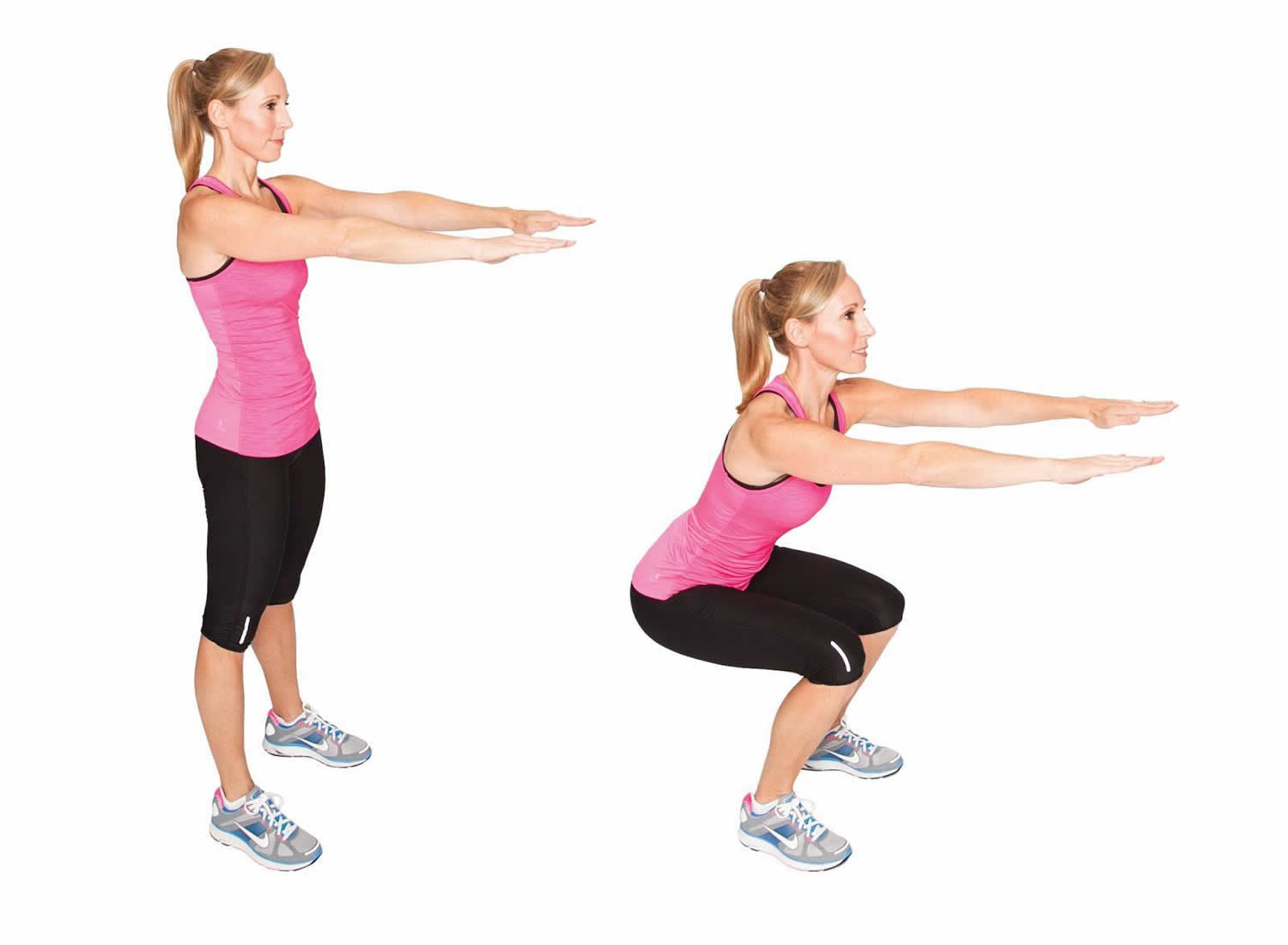
Chest Press—for chest muscles and triceps
- Lie on your back with your feet flat and knees bent.
- Grip dumbbells and extend upward but don’t lock the elbows. Slowly lower to the starting position.
- Alternatives—Sit on a stability ball and perform same movement. Simple pushups also work these muscles. A variation in push-ups could be putting your feet on a chair simulating an incline chest press.
Figure 2. Chest Press
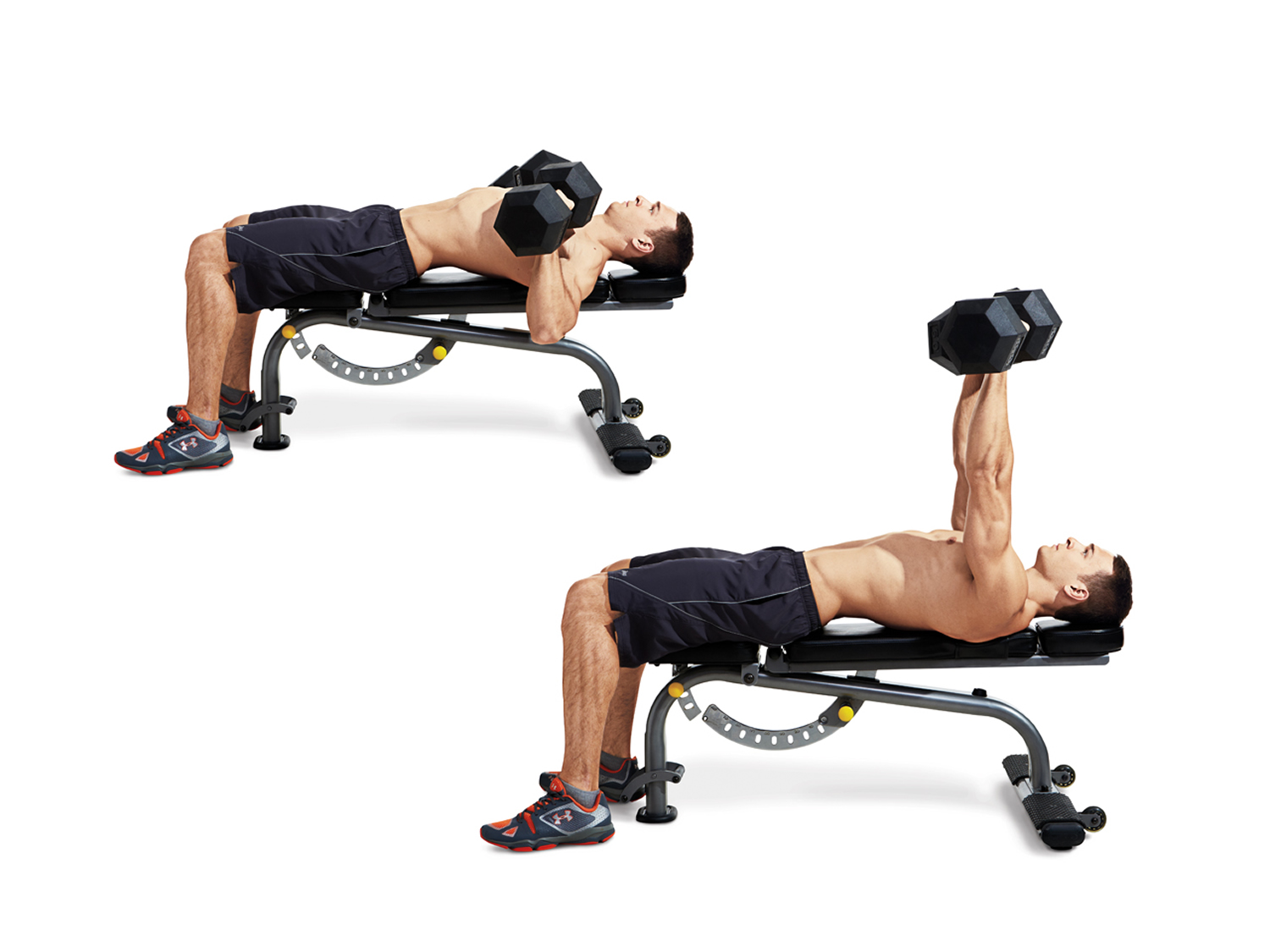
Back Extension—for buttocks (gluteals) and low back
- Lie face down on the floor.
- Raise left arm and right leg off the floor with head and neck in line with the arm. Hold for 1-2 seconds, and then slowly lower the arm and leg back to the starting position. Repeat this movement for the right arm and left leg.
- Alternative—Perform the movement on all fours or lying face down on a stability ball.
Figure 3. Back Extension

Standing Lunges—for front of thighs (quadriceps) and buttocks
- With one leg, step backward until the thigh of the forward leg is parallel to the ground or as far as feels comfortable. Your back knee should come close to the floor but not touch it.
- Push with the front leg, driving your heel into the floor, to return to the starting position.
- Alternative—Using a regular-height chair, do bench step-ups from the floor in an “up-up-down-down” pattern. To increase resistance in this exercise, hold dumbbells in your hands.
Figure 4. Standing Lunges
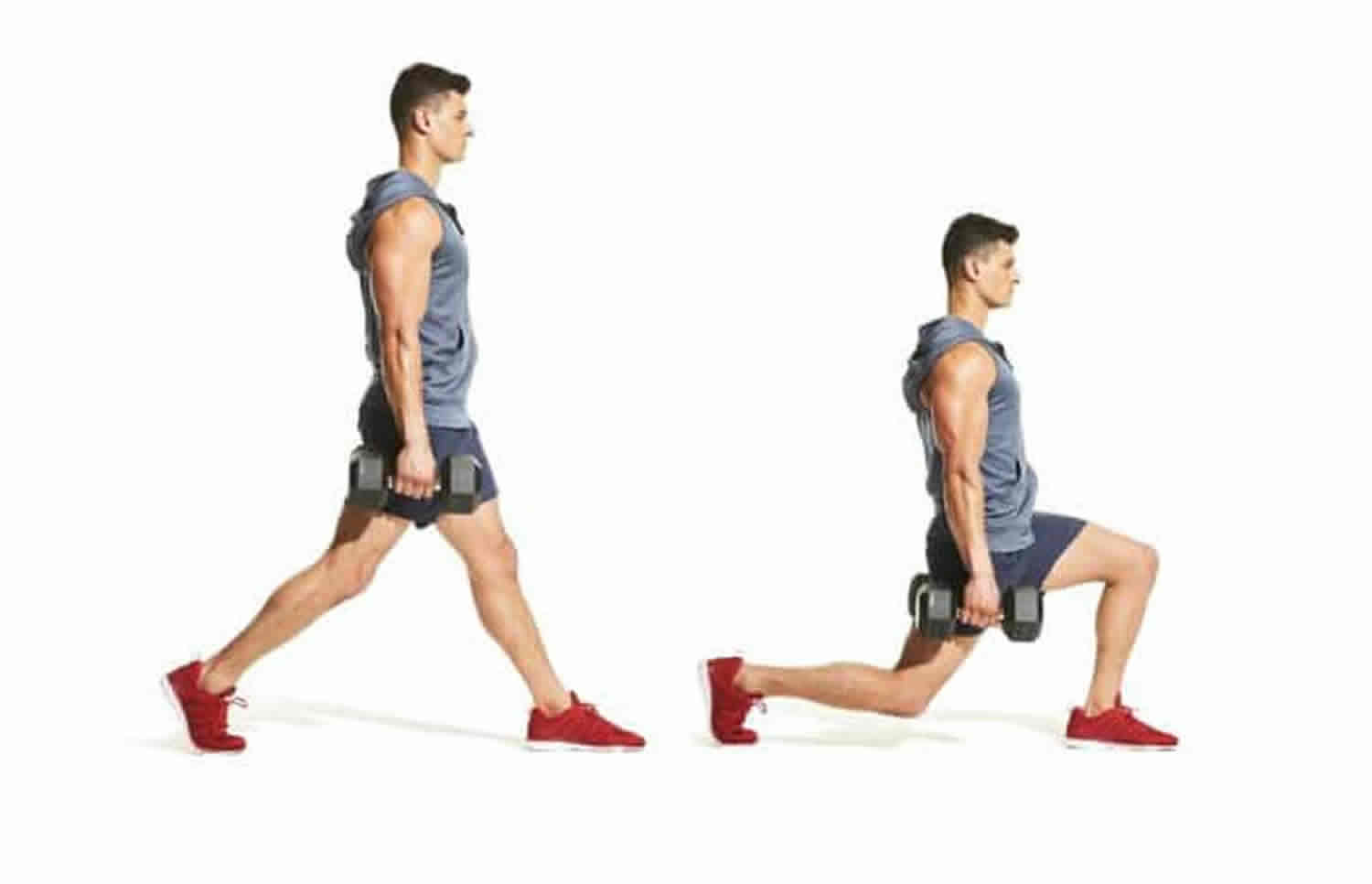
Dumbell Shoulder Press—for shoulders
- Perform this movement sitting in a regular chair, standing or sitting on a stability ball. Hold a dumbbell in each hand with an overhand grip. Make a 90-degree angle with your arms by raising the dumbbells so they are level with your ears.
- Slowly raise dumbbells over your head until arms are fully extended, but do not lock your elbows. Slowly lower the dumbbells to the starting position.
- Alternative—Perform a lateral raise by lifting the arms to the sides with a slight bend in the elbows. Keep the weights and arms below shoulder height. You will likely need lower weight for this exercise compared to shoulder press.
Figure 5. Dumbell Shoulder Press
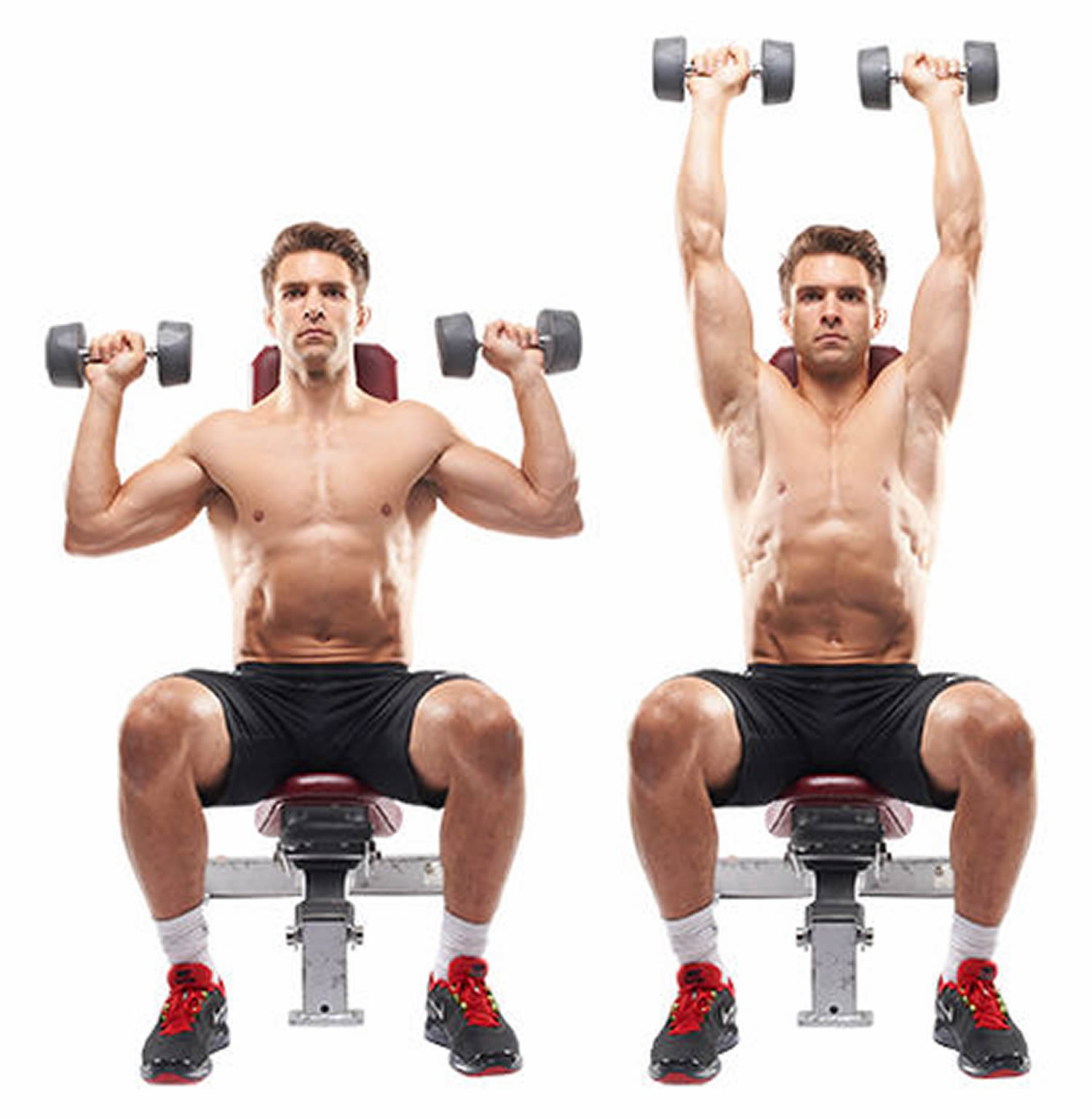
Pelvic Tilt—for abdominals and buttocks
- Lie on the floor with feet flat on the ground and knees bent. Keep arms at your sides with palms facing the floor.
- Raise your pelvis so your buttocks and lower back are off the floor. Pause, and then slowly lower your pelvis to the floor.
- Alternatives—Perform a standard crunch while sitting on a stability ball or on the floor. Try a reverse curl by lying on your back and place arms to the side with the palms face down and knees bent. Raise the knees to the chest lifting the hips off the floor.
Figure 6. Pelvic Tilt
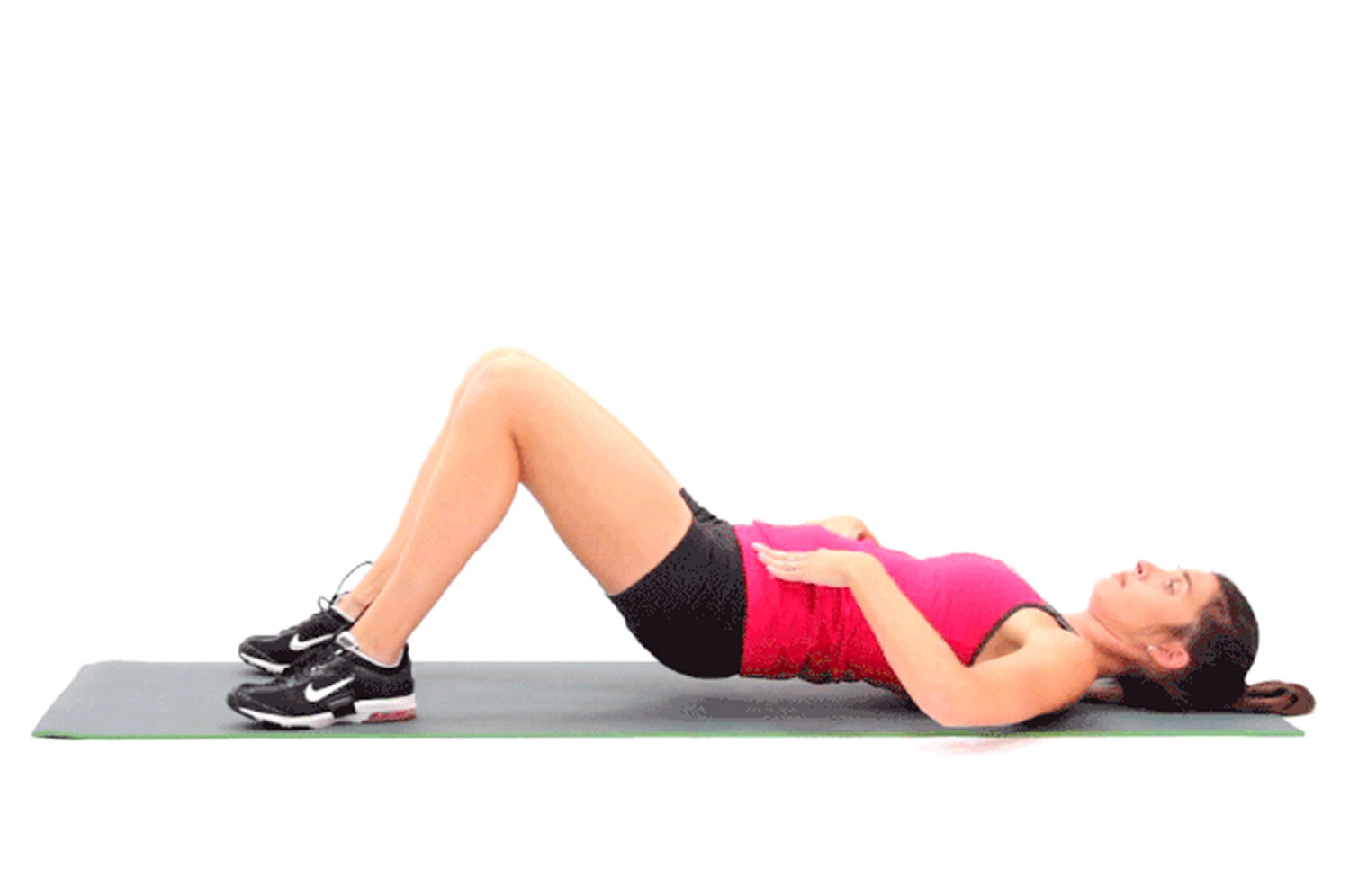
Leg Curl—for back of thighs (hamstrings)
- Stand behind a chair, and with your foot flexed, slowly bend one leg at the knee, raising your heel up toward your buttocks. Keep your support leg slightly bent.
- Slowly lower your foot back to the ground. Add ankle weights to increase resistance or use a resistance band.
- Alternative—Perform a hamstring roll using a stability ball. Lie on your back with your knees bent and your heels on the ball. Raise your hips off the floor and roll the ball away from you until your legs are straight. Roll the ball inward and outward.
Figure 7. Leg Curl
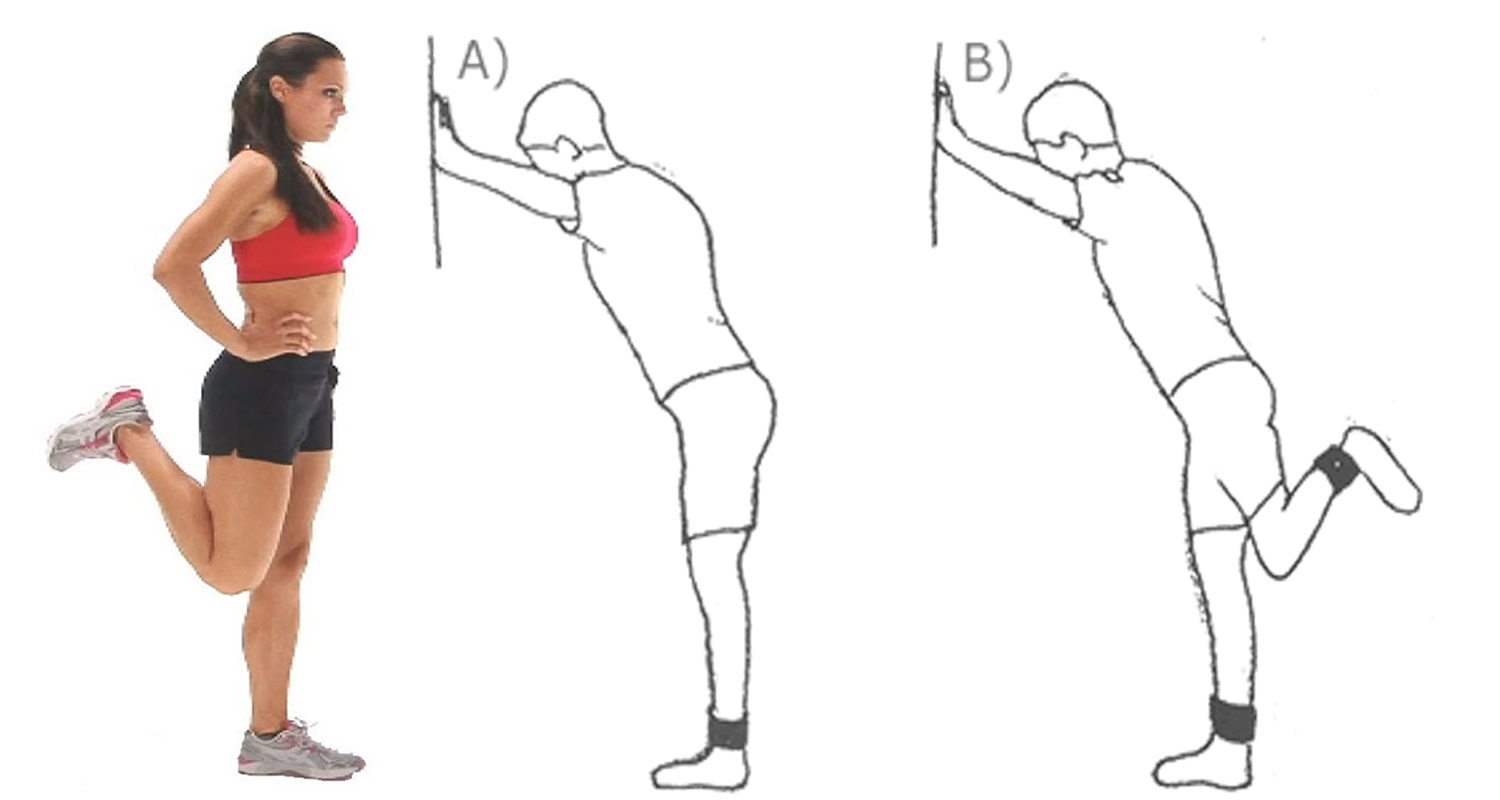
Dumbbell Row—for back musculature and biceps
- Stand with feet shoulder-width apart. Hold a dumbbell in each hand with elbows slightly bent. Bend forward at the waist and keep a slight bend in the knees.
- Pull dumbbells up to your sides until your upper arms are almost parallel to the ground. Slowly return the dumbbells to the starting position.
- Alternative—With resistance bands, stand on the band in its most middle section while holding the ends of the resistance band with your hands.
Figure 8. Dumbell Row
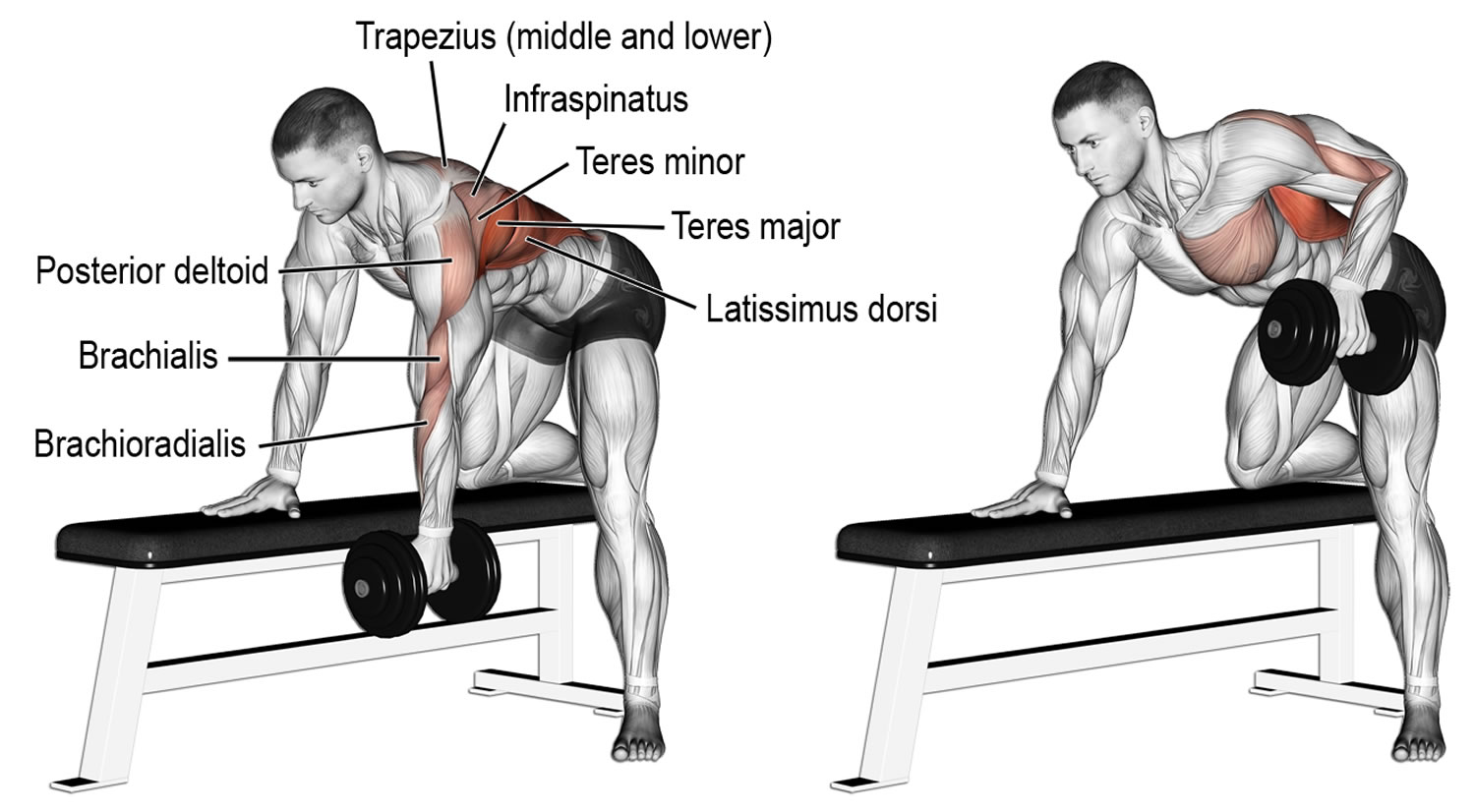
Biceps Curl—for biceps
- Stand with a dumbbell in each hand and your palms facing your thighs.
- Slowly lift the weights and rotate your forearm so that your palms end up facing your shoulders at the top of the movement. Slowly lower to the starting position so that your palms are facing your thighs.
- Alternative—With resistance bands, stand on the band in its most middle location while holding the ends of the resistance band with your hands while performing the movement.
Figure 9. Biceps Curl

Side Plank—for core
- Lie on your side with left leg on top of the right. Raise upper body and place right elbow beneath the right shoulder.
- Your elbow should be bent at a 90-degree angle and resting on the ground. Hold for up to 60 seconds.
- Alternative—Perform a standard plank by lying face down resting on the forearms with your palms flat on the floor. Rise up onto your toes and rest on your elbows, keeping your back straight and flat.
Figure 10. Side Plank
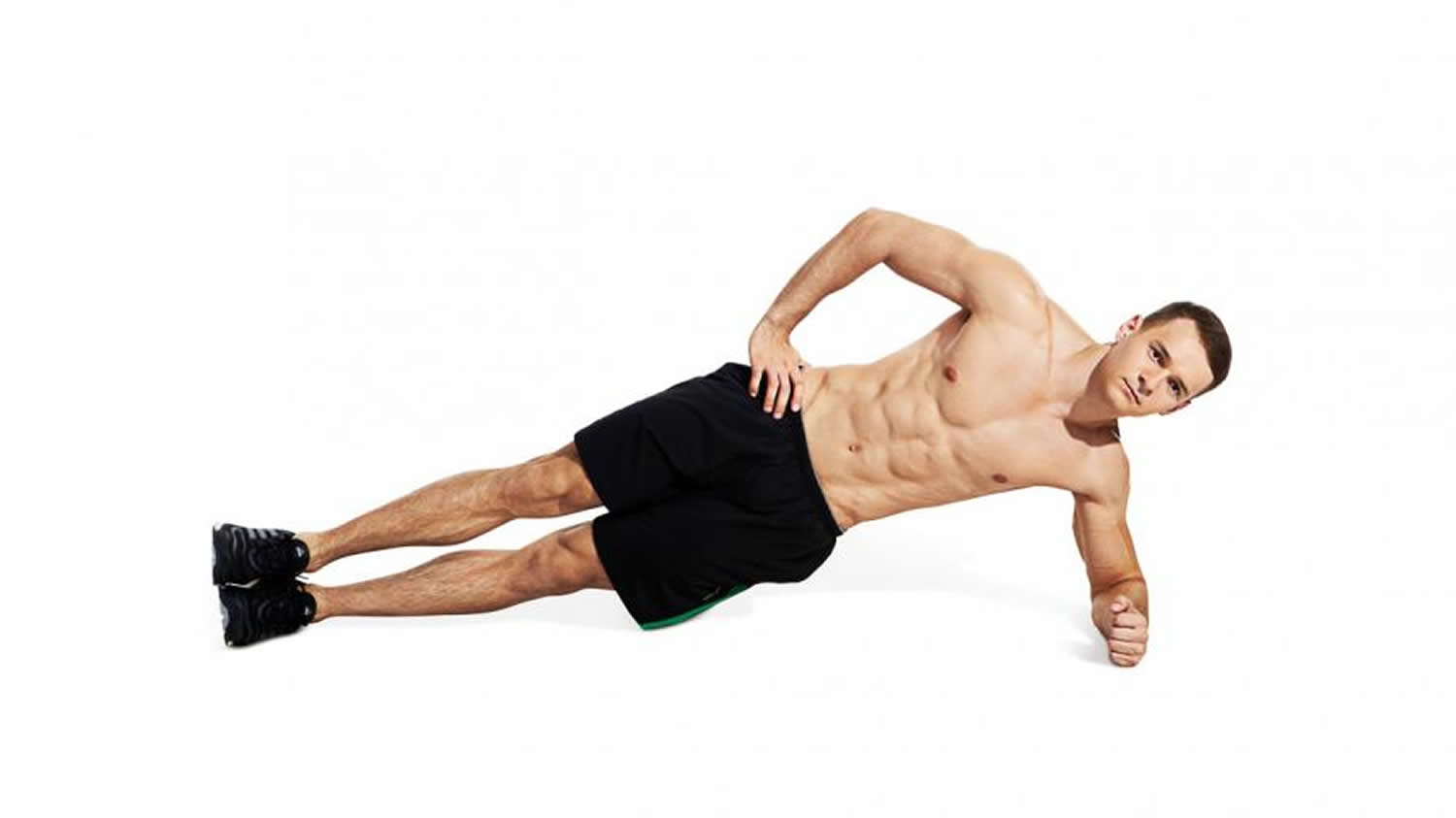
- The American College of Sports Medicine. Resistance Training for Health and Fitness. https://www.acsm.org/docs/brochures/resistance-training.pdf
- American College of Sports Medicine. Progression models in resistance training for healthy adults. Med Sci Sports Exerc. 2002;34:364-80.
- Medicine & Science in Sports & Exercise. 41(3):687-708, March 2009.
- Komi PV, Kaneko M, Aura O. EMG activity of leg extensor muscles with special reference to mechanical efficiency in concentric and eccentric exercise. Int J Sports Med. 1987;8(Suppl):22-9. https://www.ncbi.nlm.nih.gov/pubmed/3583516
- Bonde-Peterson F, Knuttgen HG, Henriksson J. Muscle metabolism during exercise with concentric and eccentric contractions. J Appl Physiol. 1972;33:792-5. https://www.ncbi.nlm.nih.gov/pubmed/4643859
- Hather BM, Tesch PA, Buchanan P, Dudley GA. Influence of eccentric actions on skeletal muscle adaptations to resistance training. Acta Physiol Scand. 1991;143:177-85. https://www.ncbi.nlm.nih.gov/pubmed/1835816
- Ebbeling CB, Clarkson PM. Exercise-induced muscle damage and adaptation. Sports Med. 1989;7:207-34. https://www.ncbi.nlm.nih.gov/pubmed/2657962
- Dudley GA, Tesch PA, Miller BJ, Buchanan MD. Importance of eccentric actions in performance adaptations to resistance training. Aviat Space Environ Med. 1991;62:543-50. https://www.ncbi.nlm.nih.gov/pubmed/1859341
- Farthing JP, Chilibeck PD. The effects of eccentric and concentric training at different velocities on muscle hypertrophy. Eur J Appl Physiol. 2003;89:578-86.
- Jackson A, Jackson T, Hnatek J, West J. Strength development: using functional isometrics in an isotonic strength training program. Res Q Exerc Sport. 1985;56:234-7.
- McGill SM. Low back stability: from formal description to issues for performance and rehabilitation. Exerc Sports Sci Rev. 2001;29:26-31. https://www.ncbi.nlm.nih.gov/pubmed/11210443
- Munn J, Herbert RD, Hancock MJ, Gandevia SC. Resistance training for strength: effect of number of sets and contraction speed. Med Sci Sports Exerc. 2005;37:1622-6. www.ncbi.nlm.nih.gov/pubmed/16177617
- Shepstone TN, Tang JE, Dallaire S, et al. Short-term high- vs. low-velocity isokinetic lengthening training results in greater hypertrophy of the elbow flexors in young men. J Appl Physiol. 2005;98:1768-76.
- Hunter GR, Seelhorst D, Snyder S. Comparison of metabolic and heart rate responses to super slow vs. traditional resistance training. J Strength Cond Res. 2003;17:76-81. www.ncbi.nlm.nih.gov/pubmed/12580660
- Farthing JP, Chilibeck PD. The effects of eccentric and concentric training at different velocities on muscle hypertrophy. Eur J Appl Physiol. 2003;89:578-86.
- Munn J, Herbert RD, Hancock MJ, Gandevia SC. Resistance training for strength: effect of number of sets and contraction speed. Med Sci Sports Exerc. 2005;37:1622-6. https://www.ncbi.nlm.nih.gov/pubmed/16177617
- Cronin J, McNair PJ, Marshall RN. The effects of bungy weight training on muscle function and functional performance. J Sports Sci. 2003;21:59-71. www.ncbi.nlm.nih.gov/pubmed/12587892
- Kraemer WJ, RatamessNA. Fundamentals of resistance training: progression and exercise prescription. Med Sci Sport Exerc. 2004;36:674-8. https://www.ncbi.nlm.nih.gov/pubmed/15064596
- Chilibeck PD, Calder AW, Sale DG, Webber CE. A comparison of strength and muscle mass increases during resistance training in young women. Eur J Appl Physiol. 1998;77:170-5. https://www.ncbi.nlm.nih.gov/pubmed/9459538
- Stone MH, Plisk SS, Stone ME, et al. Athletic performance development: volume load-1 set vs. multiple sets, training velocity and training variation. NSCA J. 1998;20:22-31.
- McCurdy KW, Langford GA, Doscher MW, Wiley LP, Mallard KG. The effects of short-term unilateral and bilateral lower-body resistance training on measures of strength and power. J Strength Cond Res. 2005;19:9-15. www.ncbi.nlm.nih.gov/pubmed/15705051
- Kibler WB, Press J, Sciascia A. The role of core stability in athletic function. Sports Med. 2006;36:189-98. https://www.ncbi.nlm.nih.gov/pubmed/16526831
- Anderson K, Behm DG. Trunk muscle activity increases with unstable squat movements. Can J Appl Physiol. 2005;30:33-45. https://www.ncbi.nlm.nih.gov/pubmed/15855681
- McCaw ST, Friday JJ. A comparison of muscle activity between a free weight and machine bench press. J Strength Cond Res. 1994;8:259-64.
- Boyer BT. A comparison of the effects of three strength training programs on women. J Appl Sports Sci Res. 1990;4:88-94.
- Willoughby DSGillespie JW. A comparison of isotonic free weights and omnikinetic exercise machines on strength. J Human Mov Stud. 1990;19:93-100.
- Sforzo GA, Touey PR. Manipulating exercise order affects muscular performance during a resistance exercise training session. J Strength Cond Res. 1996;10:20-4.
- Baker D, Newton RU. Acute effect on power output of alternating an agonist and antagonist muscle exercise during complex training. J Strength Cond Res. 2005;19:202-5. www.ncbi.nlm.nih.gov/pubmed/15705035
- Maynard J, Ebben WP. The effects of antagonist prefatigue on agonist torque and electromyography. J Strength Cond Res. 2003;17:469-74.
- Simao R, Farinatti PTV, Polito MD, Viveiros L, Fleck SJ. Influence of exercise order on the number of repetitions performed and perceived exertion during resistance exercise in women. J Strength Cond Res. 2007;21:23-8. www.ncbi.nlm.nih.gov/pubmed/17313265
- Spreuwenberg LP, Kraemer WJ, Spiering BA, et al. Influence of exercise order in a resistance-training exercise session. J Strength Cond Res. 2006;20:141-4. www.ncbi.nlm.nih.gov/pubmed/16503673
- Simao R, Farinatti PTV, Polito MD, Maior AS, Fleck SJ. Influence of exercise order on the number of repetitions performed and perceived exertion during resistive exercises. J Strength Cond Res. 2005;19:152-6. www.ncbi.nlm.nih.gov/pubmed/15705026
- Mayo Foundation for Medical Education and Research. Sprint, rest, repeat: Exploring the benefits of high-intensity interval training. http://www.mayoclinic.org/medical-professionals/clinical-updates/physical-medicine-rehabilitation/sprint-rest-repeat-exploring-the-benefits-of-high-intensity-interval-training
- Gibala MJ, Little JP, Essen MV, et al.. Short-term sprint interval versus traditional endurance training: similar initial adaptations in human skeletal muscle and exercise performance. J Physiol. 2006; 575 (3): 901–11.
- Murphy E, Schwarzkopf R. Effects of standard set and circuit weight training on excess post-exercise oxygen consumption. J Strength Cond Res. 1992;6(2):66–124.
- Trapp EG, Chisholm DJ, Fruend J, Bouthcher SH. The effects of high-intensity intermittent exercise training on fat loss and fasting insulin levels of young women. Int J Obes. 2008;32(4):684–91.
- Wernbom M, Augustsson J, Thomee R. The influence of frequency, intensity, volume and mode of strength training on whole muscle cross-sectional area in humans. Sports Med. 2007;37(3):225–64. https://www.ncbi.nlm.nih.gov/pubmed/17326698
- Scott CB, Leighton BH, Ahearn KJ, McManus JJ. Aerobic, anaerobic, and excess postexercise oxygen consumption energy expenditure of muscular endurance and strength: 1-set of bench press to muscular fatigue. J Strength Cond Res. 2011;25(4):903–8. https://www.ncbi.nlm.nih.gov/pubmed/20703175
- Elliot DL, Goldberg L, Kuehl KS. Effects of resistance training on excess post-exercise O2 consumption. J Appl Sports Sci Res. 1992; 6: 77–81.
- Haltom R, Kraemer RR, Sloan RA, Frank K, Tryniecki JL. Circuit weight training and its effects on excess postexercise oxygen consumption. Med Sci Sports Exerc. 1999; 31: 1202–7.
- Heden L, Lox C, Rose P, Reid S, Kirk EP. One set resistance training elevates energy expenditure for 72 hours similar to three sets. Eur J Appl Physiol. 2011; 111 (3): 477–84.
- Moller N, Schmitz O, Porksen N, Moller J, Jorgenson JO. Dose-response studies on the metabolic effects of a growth hormone pulse in humans. Metabolism. 1992;41(2):172–5. https://www.ncbi.nlm.nih.gov/pubmed/1736039
- J Transl Med. 2012; 10: 237. High-Intensity Interval Resistance Training (HIRT) influences resting energy expenditure and respiratory ratio in non-dieting individuals. https://www.ncbi.nlm.nih.gov/pmc/articles/PMC3551736/
- Kraemer WJ. A series of studies-the physiological basis for strength training in American football: fact over philosophy. J Strength Cond Res. 1997;11:131-42.
- Behm DG, Reardon G, Fitzgerald J, Drinkwater E. The effect of 5, 10, and 20 repetition maximums on the recovery of voluntary and evoked contractile properties. J Strength Cond Res. 2002; 16:209-18. www.ncbi.nlm.nih.gov/pubmed/11991772
- Ratamess NA, Falvo MJ, Mangine GT, et al. The effect of rest interval length on metabolic responses to the bench press exercise. Eur J Appl Physiol. 2007;100:1-17. www.ncbi.nlm.nih.gov/pubmed/17237951
- Harber MP, Fry AC, Rubin MR, Smith JC, Weiss LW. Skeletal muscle and hormonal adaptations to circuit weight training in untrained men. Scand J Med Sci Sports. 2004;14:176-85. www.ncbi.nlm.nih.gov/pubmed/15144358
- Pincivero DM, Lephart SM, Karunakara RG. Effects of rest interval on isokinetic strength and functional performance after short term high intensity training. Br J Sports Med. 1997;31:229-34. www.ncbi.nlm.nih.gov/pubmed/9298559
- Robinson JM, Stone MH, Johnson RL, et al. Effects of different weight training exercise/rest intervals on strength, power, and high intensity exercise endurance. J Strength Cond Res. 1995;9:216-21.
- Weiss LW, Coney HD, Clark FC. Differential functional adaptations to short-term low- moderate-, and high-repetition weight training. J Strength Cond Res. 1999;13:236-41.
- Rhea MR, Phillips WT, Burkett LN, et al. A comparison of linear and daily undulating periodized programs with equated volume and intensity for local muscular endurance. J Strength Cond Res. 2003;17:82-7. https://www.ncbi.nlm.nih.gov/pubmed/12580661
- Häkkinen K, Alen M, Komi PV. Changes in isometric force-and relaxation-time, electromyographic and muscle fibre characteristics of human skeletal muscle during strength training and detraining. Acta Physiol Scand. 1985;125:573-85. https://www.ncbi.nlm.nih.gov/pubmed/4091001
- O’Shea P. Effects of selected weight training programs on the development of strength and muscle hypertrophy. Res Q. 1966;37:95-102.
- Campos GE, Luecke TJ, Wendeln HK, et al. Muscular adaptations in response to three different resistance-training regimens: specificity of repetition maximum training zones. Eur J Appl Physiol. 2002;88:50-60.
- Fleck SJ. Periodized strength training: a critical review. J Strength Cond Res. 1999;13:82-9.
- Rhea MR, Alvar BA, Burkett LN, Ball SD. A meta-analysis to determine the dose response for strength development. Med Sci Sports Exerc. 2003;35:456-64. https://www.ncbi.nlm.nih.gov/pubmed/12618576
- Peterson MD, Rhea MR, Alvar BA. Maximizing strength development in athletes: a meta-analysis to determine the dose-response relationship. J Strength Cond Res. 2004;18:377-82. https://www.ncbi.nlm.nih.gov/pubmed/15142003
- Ratamess NA, Faigenbaum AD, Hoffman JR, Kang J. Self-selected resistance training intensity in healthy women: the influence of a personal trainer. J Strength Cond Res. 2008;22:103-11.
- Tran QT, Docherty D, Behm D. The effects of varying time under tension and volume load on acute neuromuscular responses. Eur J Appl Physiol. 2006;98:402-10. https://www.ncbi.nlm.nih.gov/pubmed/16969639
- Dudley GA, Djamil R. Incompatibility of endurance- and strength-training modes of exercise. J Appl Physiol. 1985;59:1446-51. https://www.ncbi.nlm.nih.gov/pubmed/4066574
- Mayhew JL, Gross PM. Body composition changes in young women with high resistance training. Res Q. 1974;45:433-40.
- Staron RS, Karapondo DL, Kraemer WJ, et al. Skeletal muscle adaptations during early phase of heavy-resistance training in men and women. J Appl Physiol. 1994;76:1247-55.
- Hortobagyi T, Barrier J, Beard D, et al. Greater initial adaptations to submaximal muscle lengthening than maximal shortening. J Appl Physiol. 1996;81:1677-82. https://www.ncbi.nlm.nih.gov/pubmed/8904586
- Housh DJ, Housh TJ, Johnson GO, Chu WK. Hypertrophic response to unilateral concentric isokinetic resistance training. J Appl Physiol. 1992;73:65-70. https://www.ncbi.nlm.nih.gov/pubmed/1506400
- Sale DG, Jacobs I, MacDougall JD, Garner S. Comparisons of two regimens of concurrent strength and endurance training. Med Sci Sports Exerc. 1990;22:348-56.
- Capen EK. Study of four programs of heavy resistance exercises for development of muscular strength. Res Q. 1956;27:132-42.
- Ostrowski KJ, Wilson GJ, Weatherby R, Murphy PW, Lyttle AD. The effect of weight training volume on hormonal output and muscular size and function. J Strength Cond Res. 1997;11:148-54.
- Berger RA. Effect of varied weight training programs on strength. Res Q. 1962;33:168-81.
- Peterson MD, Rhea MR, Alvar BA. Maximizing strength development in athletes: a meta-analysis to determine the dose-response relationship. J Strength Cond Res. 2004;18:377-82. www.ncbi.nlm.nih.gov/pubmed/15142003
- Peterson MD, Rhea MR, Alvar BA. Applications of the dose-response for muscular strength development: a review of meta-analytic efficacy and reliability for designing training prescription. J Strength Cond Res. 2005;19:950-8. https://www.ncbi.nlm.nih.gov/pubmed/16287373
- Coleman AE. Nautilus vs universal gym strength training in adult males. Am Correct Ther J. 1977;31:103-7. https://www.ncbi.nlm.nih.gov/pubmed/899994
- Jacobson BH. A comparison of two progressive weight training techniques on knee extensor strength. J Athl Train. 1986;21:315-9.
- Sanborn K, Boros R, Hruby J, et al. Short-term performance effects of weight training with multiple sets not to failure vs a single set to failure in women. J Strength Cond Res. 2000;14:328-31.
- Takeshima N, Rogers M, Watanabe E, et al. Water-based exercise improves health-related aspects of fitness in older women. Med Sci Sports Exerc. 2002;33:544-51. Takeshima N, Rogers M, Watanabe E, et al. Water-based exercise improves health-related aspects of fitness in older women. Med Sci Sports Exerc. 2002;33:544-51.
- Feigenbaum MS, Pollock ML. Prescription of resistance training for health and disease. Med Sci Sports Exerc. 1999;31:38-45. https://www.ncbi.nlm.nih.gov/pubmed/9927008
- Kemmler WK, Lauber D, Engelke K, Weineck J. Effects of single- vs. multiple-set resistance training on maximum strength and body composition in trained postmenopausal women. J Strength Cond Res. 2004;18:689-94. https://www.ncbi.nlm.nih.gov/pubmed/15574068
- Kraemer WJ, Ratamess N, Fry AC, et al. Influence of resistance training volume and periodization on physiological and performance adaptations in college women tennis players. Am J Sports Med. 2000;28:626-33. https://www.ncbi.nlm.nih.gov/pubmed/11032216
- Hass CJ, Garzarella L, Dehoyos D, Pollock ML. Single versus multiple sets and long-term recreational weightlifters. Med Sci Sports Exerc. 2000;32:235-42. https://www.ncbi.nlm.nih.gov/pubmed/10647555
- Rhea MR, Alvar BA, Burkett LN. Single versus multiple sets for strength: a meta-analysis to address the controversy. Res Q Sport Exerc. 2002;73:485-8.
- Wolfe BL, Lemura LM, Cole PJ. Quantitative analysis of single- vs. multiple-set programs in resistance training. J Strength Cond Res. 2004;18:35-47. https://www.ncbi.nlm.nih.gov/pubmed/14971985
- Gonzalez-Badillo JJ, Gorostiaga EM, Arellano R, Izquierdo M. Moderate resistance training volume produces more favorable strength gains than high or low volumes during a short-term training cycle. J Strength Cond Res. 2005;19:689-97.
- Finer JT, Simmons RM, Spudich JA. Single myosin molecule mechanics: piconewton forces and nanometre steps. Nature. 1994;368:113-9. https://www.ncbi.nlm.nih.gov/pubmed/8139653
- Knapik JJ, Mawdsley RH, Ramos MU. Angular specificity and test mode specificity of isometric and isokinetic strength training. J Orthop Sports Phys Ther. 1983;5:58-65. https://www.ncbi.nlm.nih.gov/pubmed/18806429
- Henneman E, Somjen G, Carpenter D. Functional significance of cell size in spinal motoneurons. J Neurophysiol. 1965; 28:560-80. https://www.ncbi.nlm.nih.gov/pubmed/14328454
- Coburn JW, Housh TJ, Malek MH, et al. Neuromuscular responses to three days of velocity-specific isokinetic training. J Strength Cond Res. 2006;20:892-8.
- Candow DG, Burke DG. Effect of short-term equal-volume resistance training with different workout frequency on muscle mass and strength in untrained men and women. J Strength Cond Res. 2007;21:204-7. https://www.ncbi.nlm.nih.gov/pubmed/17313289
- Graves JE, Pollock ML, Leggett SH, et al. Effect of reduced training frequency on muscular strength. Int J Sports Med. 1988;9:316-9. https://www.ncbi.nlm.nih.gov/pubmed/3246465
- McLester JR, Bishop P, Guilliams ME. Comparison of 1 day and 3 days per week of equal-volume resistance training in experienced subjects. J Strength Cond Res. 2000;14:273-81.
- Graves JE, Pollock ML, Jones AE, Colvin AB, Leggett SH. Specificity of limited range of motion variable resistance training. Med Sci Sports Exerc. 1989;21:84-9. www.ncbi.nlm.nih.gov/pubmed/2927306
- Hunter GR. Changes in body composition, body build, and performance associated with different weight training frequencies in males and females. NSCA J. 1985;7:26-8.
- Pollock ML, Graves JE, Bamman MM, et al. Frequency and volume of resistance training: effect of cervical extension strength. Arch Phys Med Rehabil. 1993;74:1080-6. www.ncbi.nlm.nih.gov/pubmed/8215860
- Gillam GM. Effects of frequency of weight training on muscle strength enhancement. J Sports Med. 1981;21:432-6.
- Hoffman JR, Kraemer WJ, Fry AC, Deschenes M, Kemp DM. The effect of self-selection for frequency of training in a winter conditioning program for football. J Appl Sport Sci Res. 1990;3:76-82.
- Häkkinen K, Pakarinen A, Alen M, Kauhanen H, Komi PV. Neuromuscular and hormonal responses in elite athletes to two successive strength training sessions in one day. Eur J Appl Physiol. 1988;57:133-9. www.ncbi.nlm.nih.gov/pubmed/3349977
- Zatsiorsky V, Kraemer WJ. Science and Practice of Strength Training. 2nd ed. Champaign (IL): Human Kinetics; 2006.
- Häkkinen K, Kallinen M. Distribution of strength training volume into one or two daily sessions and neuromuscular adaptations in female athletes. Electromyogr Clin Neurophysiol. 1994;34:117-24. www.ncbi.nlm.nih.gov/pubmed/8187678
- Fleck SJ, Kraemer WJ. Designing Resistance Training Programs. 2nd ed. Champaign (IL): Human Kinetics Books; 1997. p. 1-115.
- Rhea MR, Alvar BA, Burkett LN, Ball SD. A meta-analysis to determine the dose response for strength development. Med Sci Sports Exerc. 2003;35:456-64. www.ncbi.nlm.nih.gov/pubmed/12618576
- Fleck SJ. Cardiovascular adaptations to resistance training. Med Sci Sports Exerc. 1988;20:S146-51. https://www.ncbi.nlm.nih.gov/pubmed/3057314
- Hurley BF, Kokkinos PF. Effects of weight training on risk factors for coronary heart disease. Sports Med. 1987;4:231-8. https://www.ncbi.nlm.nih.gov/pubmed/3306865
- Miller WJ, Sherman WM, Ivy JL. Effect of strength training on glucose tolerance and post-glucose insulin response. Med Sci Sports Exerc. 1984;16:539-43. https://www.ncbi.nlm.nih.gov/pubmed/6392812
- Layne JE, Nelson ME. The effect of progressive resistance training on bone density: a review. Med Sci Sports Exerc. 1999;31:25-30. https://www.ncbi.nlm.nih.gov/pubmed/9927006
- Koffler KH, Menkes A, Redmond RA, et al. Strength training accelerates gastrointestinal transit in middle-aged and older men. Med Sci Sports Exerc. 1992;24:415-9. https://www.ncbi.nlm.nih.gov/pubmed/1560736
- Evans WJ. Exercise training guidelines for the elderly. Med Sci Sports Exerc. 1999;31:12-7. https://www.ncbi.nlm.nih.gov/pubmed/9927004
- Ewart CK. Psychological effects of resistive weight training: implications for cardiac patients. Med Sci Sports Exerc. 1989;21:683-8.
